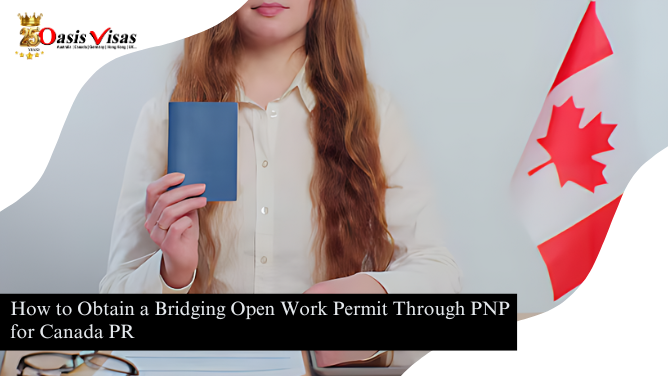
Canada is a top destination for immigrants looking for better career opportunities and a high quality of life. Many people apply for Canada PR through different immigration programs, including the Provincial Nominee Program (PNP). However, the processing time for Canada permanent residency applications can take several months, during which applicants may be worried about their legal status and ability to work. This is where the Bridging Open Work Permit (BOWP) comes in.
The BOWP allows eligible Canada PR applicants to continue working in Canada while waiting for their PR application to be processed. If you have applied for Canada PR through PNP, you may be eligible for a BOWP under certain conditions. This blog will explain everything you need to know about obtaining a Bridging Open Work Permit through PNP, including eligibility requirements, application steps, and benefits.
What is a Bridging Open Work Permit (BOWP)?
A Bridging Open Work Permit (BOWP) is a temporary work permit that allows Canada PR applicants to stay and work in Canada while their PR application is being processed. This work permit is “open,” meaning you can work for any employer in Canada instead of being restricted to a specific employer or job.
The BOWP is particularly helpful for individuals applying for Canada PR through Express Entry or PNP, as it prevents gaps in employment due to work permit expiration. If you meet the eligibility criteria, you can continue working in Canada without needing a Labour Market Impact Assessment (LMIA).
Eligibility Criteria for a BOWP Through PNP
To qualify for a BOWP through the Provincial Nominee Program (PNP), you must meet the following conditions:
- You have applied for Canada PR: Your permanent residence application must be submitted and accepted under the PNP.
- Your current work permit is expiring: A BOWP is designed for those whose work permit is about to expire, allowing them to keep working while waiting for PR approval.
- You have a nomination from a Canadian province or territory: The nomination must be valid, and you should have received a letter of support from the provincial government.
- You have no employment restrictions: If your PNP nomination is employer-specific, you might not be eligible for a BOWP.
- You are in Canada at the time of application: Applicants must be inside Canada when applying for a BOWP.
- You meet the general work permit requirements: This includes having valid status in Canada and complying with all immigration regulations.
How to Apply for a BOWP Through PNP?
If you meet the eligibility criteria, follow these steps to apply for a Bridging Open Work Permit through PNP:
Step 1: Gather Required Documents
Before starting your application, ensure you have all the necessary documents, including:
- A copy of your Acknowledgement of Receipt (AOR) from Immigration, Refugees, and Citizenship Canada (IRCC), confirming your Canada PR application is being processed.
- A copy of your Provincial Nomination Certificate and support letter from the province.
- A valid passport with enough validity remaining.
- Proof of current legal status in Canada, such as a valid work permit.
- Any additional documents requested by IRCC.
Step 2: Submit Your Application and Wait for Approval
Once your application is submitted, IRCC will review it. Processing times can vary, but typically it takes several weeks. You can check the status of your application online through your IRCC account.
Benefits of a Bridging Open Work Permit Through PNP
Getting a BOWP through PNP comes with several advantages:
- Continuity of Employment: You can continue working in Canada while waiting for your Canada permanent residency approval.
- Flexibility: Unlike employer-specific work permits, a BOWP allows you to work for any employer in Canada.
- No Need for an LMIA: The employer does not need to go through the Labour Market Impact Assessment (LMIA) process, making it easier to find jobs.
- Financial Stability: You can earn a steady income and support yourself and your family while your Canada PR is being processed.
- Access to Healthcare and Other Benefits: Some provinces allow BOWP holders to access healthcare and social benefits.
Common Reasons for BOWP Rejection and How to Avoid Them
Even though many applicants successfully receive a BOWP, some applications get rejected. Here are common reasons and how to avoid them:
1. Incomplete Application: Ensure all required documents are submitted correctly.
2. Expired Nomination: Your provincial nomination must be valid at the time of application.
3. Incorrect Work Permit Category: When applying, select the correct category (Bridging Open Work Permit) to avoid confusion.
4. Not Meeting Residency Requirements: You must be physically present in Canada when applying.
5. Insufficient Proof of Canada PR Application: Ensure your AOR and nomination documents are included.
Applying for a Bridging Open Work Permit through PNP is a great option for those waiting for Canada PR approval. It ensures that you can continue working in Canada without interruption and provides flexibility in choosing employers. If you are applying for Canada PR through PNP and your work permit is about to expire, consider applying for a BOWP to maintain your employment and financial stability.
By following the eligibility criteria and application steps outlined in this guide, you can increase your chances of successfully obtaining a BOWP. Always stay updated with IRCC guidelines to ensure a smooth application process and avoid delays in your journey toward Canada permanent residency.











